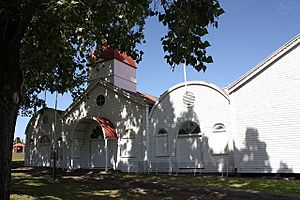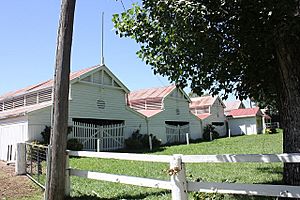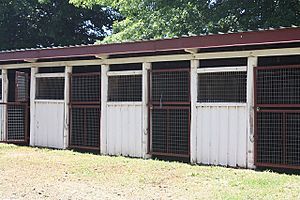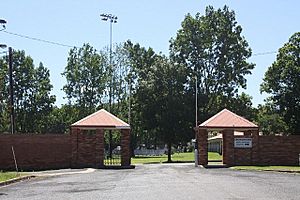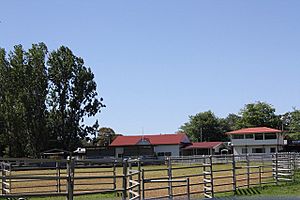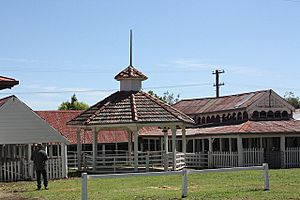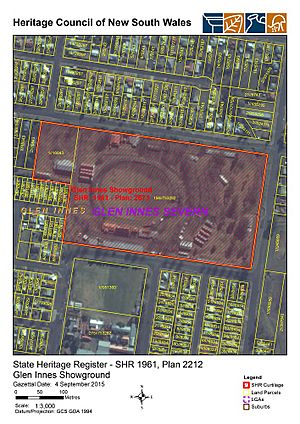Glen Innes Showground facts for kids
Quick facts for kids Glen Innes Showground |
|
|---|---|
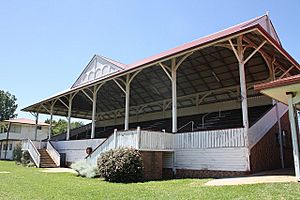
Grandstands at the showground
|
|
| Location | Bourke Street, Glen Innes, Glen Innes Severn, New South Wales, Australia |
| Built | 1873– |
| Architect | Thompson and Holmes JPO'Connor; Rowland Bros; Madigan and Cusick |
| Official name: Glen Innes Showground; Pastoral and Agricultural Showground Glen Innes | |
| Type | state heritage (complex / group) |
| Designated | 4 September 2015 |
| Reference no. | 1961 |
| Type | Showground |
| Category | Community Facilities |
| Builders | AW Lane, G Cooper, HA Tutt and Son |
| Lua error in Module:Location_map at line 420: attempt to index field 'wikibase' (a nil value). | |
The Glen Innes Showground is a special place in Glen Innes, Australia. It's listed as a heritage site because of its long history. Many different architects and builders helped create it, starting way back in 1873. It was added to the New South Wales State Heritage Register in 2015.
Contents
A Glimpse into History
First Peoples and Early Settlers
Before Europeans arrived, the land around Glen Innes belonged to the Ngarbal people. Their special animal, or totem, was the koala. Their lands stretched across many areas, including where towns like Glencoe and Bolivia are today.
During cold winters, the Ngarabal people would move to warmer areas. They followed rivers like the Clarence River. In summer, they returned to feast on animals like wallabies and possums. They also ate wild berries, yams, and other plants. Those who couldn't travel stayed warm with possum or kangaroo skin cloaks. They also built large campfires near their bark huts.
The Ngarabal people traded with other Aboriginal groups. They exchanged things like ochre (a type of clay for painting) and stone. These gatherings were also for ceremonies and sharing information.
In the early 1800s, European explorers like John Oxley and Richard Cunningham passed through the area. They saw signs of Aboriginal life but rarely met the people. It seemed the Aboriginal people were choosing to avoid the new settlers.
After 1830, more European settlers arrived. Large farming companies took over land, forcing new settlers to look further north. This included the New England area where Glen Innes is. As settlers took more land, Aboriginal people found it harder to hunt. This led to conflicts. Sometimes, Aboriginal people took livestock as a way to get food. Settlers also chased Aboriginal people from their farms.
By the 1840s, towns began to grow. Glen Innes started to develop quickly in the 1870s. This was after tin was discovered nearby. New shops and hotels opened. Groups like the Pastoral and Agricultural Association were formed. This group helped create the local show.
The Showground's Beginnings
Farming and raising animals were very important for the economy. This led to the idea of a local show. Here, farmers could display and judge their animals. The first show in the Glen Innes area was in 1869 in Inverell. The next year, in 1870, the show was held in Glen Innes. It was near the primary school.
The first show on the current showground site was in 1874. This makes Glen Innes one of the oldest shows in New South Wales. It has been held continuously on the same site. Other early showgrounds include Maitland (1873) and Singleton (1868).
In 1876, the Glen Innes group decided to form its own association. They separated from Inverell. The New South Wales government officially set aside the current showground site in 1877. This land became a key part of the town.
The first president of the Glen Innes Pastoral and Agricultural Association was William Alexander Dumaresq. His father, William John Dumaresq, was a well-known figure in the colony. The Dumaresq family owned large farms in the area.
Another important person was W. T. Cadell from Deepwater Station. This station was famous for its fine merino wool. Cadell worked hard to improve his sheep and cattle. He became a major supporter of the Glen Innes Show in 1903. He wanted to make it one of the best shows in New South Wales.
The first buildings at the showground were a Grandstand and an Exhibition Hall. These were ready for the 1874 show. As the show grew, more buildings were added. Stockyards were built too. Special trains even brought people from other towns to the show. In 1888, a grand new entrance was opened on Torrington Street.
By 1892, the original Exhibition Hall was replaced. The new Main Exhibition Pavilion is still standing today. It has a beautiful Victorian style. In 1896, the first grandstand was replaced. The new one, built in the Federation Carpenter style, opened in 1899. The timber from the old grandstand was used to build the caretaker's house.
In 1897, trees were planted to celebrate Queen Victoria's Jubilee. The showground also got lights for the first time. More trees were planted over the years. This helped create the lovely park-like setting we see today.
Many important people visited the Glen Innes Show. Premiers of New South Wales and even governors attended. By 1922, the show was known as one of the best in NSW. Its buildings and facilities were top-notch.
The early 1900s saw more building projects. New pavilions, stables, and a cattle pavilion were built. New entrance gates were put up in 1911. In 1922, a big addition was made to the Main Exhibition Pavilion. A sheep pavilion, piggery, and refreshment room were also built. The new buildings were designed to match the older ones. This kept the showground looking unified.
W. T. Cadell, the show's patron, passed away in 1922. A special sheep rotunda was built in his memory. It was opened in 1927.
In the 1930s, the showground expanded. Two more acres of land were bought. A Caged Bird Pavilion was built. A public address system was installed. However, World War II stopped further development. The Army used the showground from 1942. The show didn't happen again until 1946. The grounds needed a lot of repair after the Army left.
In the 1950s, the showground grew again. Another two acres were purchased. A Ringside Broadcast Box was added. Horse and cattle stalls were built. More trees were planted. Most of the buildings you see today were in place by then. Later additions include a bar and barbecue in 1991. New entrance gates were also built on Bourke Street.
The showground continued to evolve. In the 1970s, an Industrial pavilion was built. In the 2000s, a Men's Shed was added.
The show reflected changes in farming. First, sheep, cattle, and horses were shown. Later, crops like maize and wheat were exhibited. Dairy herds, pigs, and poultry also became important.
Local industries also grew and were featured at the show. Flour mills developed from wheat growing. Butter and cheese factories came from dairy farming. Blacksmiths and coach companies grew from horse use. This explains why buildings like the Hall of Industries were built.
Unlike many other showgrounds, Glen Innes has kept almost all its original buildings. This shows how farming and industry developed in the region. It's one of the few showgrounds with such a complete collection of historic buildings.
What You'll See Today
The Glen Innes Showground has many buildings and facilities. These include a grandstand, exhibition pavilions, cattle and sheep pavilions, and horse stalls. There are also refreshment rooms and offices. The showground is set in a beautiful, park-like area.
Main Exhibition Pavilion
The Main Exhibition Pavilion was built in 1892. It's a timber building with four sections joined together. It has a domed tower and a gabled iron roof. The walls are made of timber and corrugated iron. Inside, you can see the timber floors and ceiling. It has many windows and doors.
Grandstand
The main timber grandstand opened in 1899. It's made of strong hardwood and has a corrugated iron roof. It was designed to seat 350 people. Sydney architects Thompson and Holmes designed it. A local builder, A. W. Lane, supervised the work.
Industrial Pavilion
The Industrial Pavilion was built in 1922. It's a large building, 84 feet long and 35 feet wide. It was designed for trade displays. The floor is made of tallowood, which is also good for dancing. F. J. Madigan designed this pavilion.
Refreshment Room and Piggery
In 1921, a new refreshment room was built. This is where people could get food and drinks. A new piggery was also constructed. It had fourteen stalls for pigs.
Cadell Memorial Rotunda
The Cadell Memorial Rotunda was built in 1928. It's a fancy, eight-sided building. It has a terra cotta tiled roof. The design lets in a lot of light with a domed ceiling and glass louvres. This rotunda is used for judging sheep.
Park-like Setting
The showground buildings are surrounded by a beautiful 7-acre park. Many trees were planted here, starting in 1897. These included eucalypts, elms, and pines. The Department for Mines and Agriculture donated many trees in 1898. Over the years, more trees were added.
In the 1950s, more elms were planted. Some old pine trees were cut down. In 1958, a big tree planting program took place. In the 1960s, even more trees were planted around the show ring. By 1969, there were 250 trees growing at the showground.
Today, the showground is still filled with trees. You'll see groups of elms and eucalypts. Elms provide shade near the Main Exhibition Pavilion and around the arena.
Condition and Changes
As of 2014, some buildings needed urgent repair. These included the pavilions and the Cadell Memorial sheep judging stand. These buildings are important because they show old building skills.
The Glen Innes Showground is still very much like it was in the past. It has kept most of its original features.
Some changes have happened over time:
- The first grandstand was removed in 1896. Its timber was used for the caretaker's house.
- Additions were made to the current grandstand in 1907.
- A picket fence in front of the grandstand was removed.
- A Hall of Industries was completed in 1922.
- The Tea Room Drill Hall was taken down in the 1950s.
- The main entrances were updated in 1988 and 1990. This was after trucks damaged the old entrance.
Why It's a Heritage Site
The Glen Innes Showground is very important to the history of New South Wales. It's one of the earliest regional shows in the state. The showground has been used every year for 140 years. For many years, it was known as one of the best shows in NSW. This was because of how many people attended and the quality of its exhibits. It also had excellent facilities for showing animals and for spectators.
The showground is also important because of its connections to famous people. The Dumaresq family, who owned large farms, were involved. So was W. T. Cadell, a well-known farmer. His Deepwater Station was vital to the wool export industry.
The showground is also beautiful. It has many buildings built in the Federation style. They all look good together and are set in a park. This collection of buildings is one of the most complete in NSW. They are arranged nicely around the central arena. This makes the showground a landmark in the town.
The Glen Innes Showground can teach us a lot about the past. It shows how agricultural shows worked. It also shows how farming and industry developed in rural NSW. It's rare to find a showground with so many original buildings still standing.
It's a great example of a regional showground. It has kept all its different buildings for exhibitions, food, and spectators. Its completeness and beauty make it an "ideal" regional showground.


